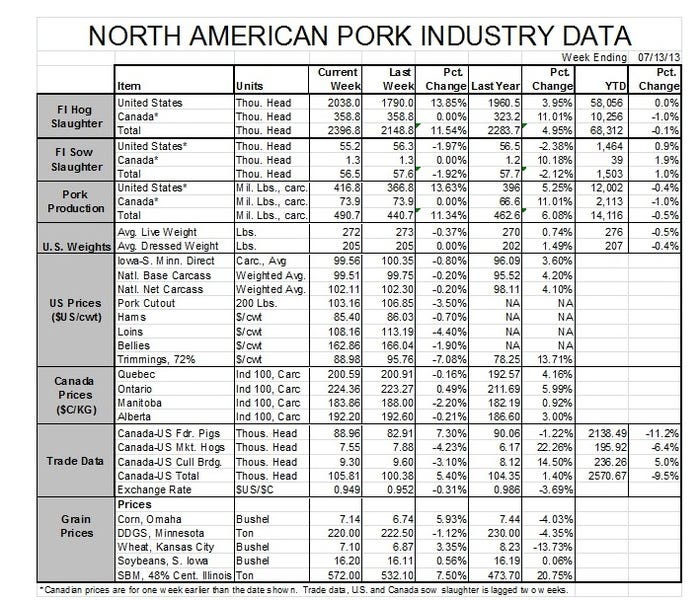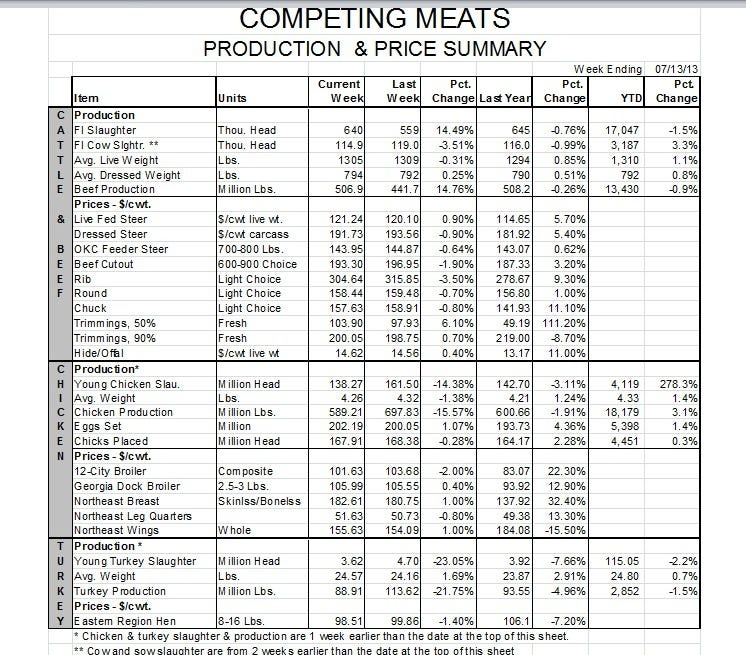USDA Holds to Corn, Soybean Yield Trend Lines
July 15, 2013

Last week’s World Agricultural Supply and Demand Estimates (WASDE) report from the U.S. Department of Agriculture (USDA) carried no big surprises.
As expected, USDA used its own acreage figures for corn and soybeans from the June 28 acreage report. The harvested acres estimate for corn is 89.1 million, slightly lower than the 89.5 million used in June. For soybeans, USDA stuck with its forecast of 76.2 million acres harvested. The planted acreage is pretty well fixed at this point and it is too early to quibble about harvested acres.
USDA did not change its forecasts for either the corn or soybean yield, still basing those numbers on long-term trends until the first objective measurement data are available in August.
USDA did increase its estimate for corn imports for this year by 10 million bushels and increased feed/residual usage by 50 million bushels. Those two changes drove 2012-2013 carryout stocks to 729 million bushels from 769 million bushels or just 6.5% of projected total use and making a tight stocks situation even tighter. The increase in feed/residual use was made to reflect the lateness of this year’s crop – a factor that has, in effect, made the 2012-13 marketing year about 14 months long. Recall that we dipped into 2012 corn supplies early last summer; this year they will have to last longer.
Like what you're reading? Subscribe to the National Hog Farmer Weekly Preview newsletter and get the latest news delivered right to your inbox every Monday!
Add in some tweaks for various 2013-14 forecast uses, that amounts to a 100-million bushel reduction in total usage and USDA’s projected 2014 carryout stocks increased to 1.959 billion bushels or 15.4% of total usage. That would be a much more comfortable stock level indeed!
It is important to note that futures markets for corn and soybeans are carrying weather premiums at this point, though, and we concur that there is still significant weather risk. June rainfall has been below normal in much of the Corn Belt from Indiana westward. Temperatures have not been damagingly high yet, but millions of acres of corn need a good drink of water just now as pollination begins. An equation relating December corn futures price to yield derived by Iowa State University’s Robert Wisner suggests that the corn futures market is reflecting a national yield of about 149 bu./acre at this time.
The premium in the soybean and soybean meal markets are even larger. New crop beans are $1.75/bu. or so higher than the mid-point of USDA’s forecast price range, while soybean meal is about $65/ton higher than USDA’s $320/ton midpoint. This late-planted soybean crop will likely require a late frost to reach USDA current yield forecast, and we won’t know if that happens until the day it actually happens!
Bottom line: It’s still the weather!


Congratulations, Dale
Finally, I write today with a bit of a heavy heart as I contemplate writing this column and working each week without Dale Miller at the helm of National Hog Farmer. Today is his last day as he retires from the work that he has done for his entire adult life. Thank goodness we are not losing Dale for good as I know he will still be involved in the pork industry, and I fully expect to see him and even work with him in the years to come. But it won’t be the same, either, and that brings a note of melancholy to this day.
We come from different yet similar backgrounds. He grew up on a diversified Minnesota farm and has had a life-long interest and love for Chester White hogs. I didn’t grow up on a farm, but I first knew Dale when I was raising purebred Chester Whites in the ’80s and ‘90s. We would both argue that it takes a particularly optimistic and persevering sort to raise Chesters and that the experience has served us well. If you don’t buy that, just answer this question: Have you ever driven a Chester White boar in a show ring with 10 or 15 other Chester White boars? If not, believe Dale and me when we say it’s not for the faint of heart and can be one of those “character builders” that your dad was always so fond of pointing out.
As a Chester White breeder and as a professional journalist, I know of no layman who was more in tune with the science of pigs. Under Dale’s leadership, National Hog Farmer became the place to look for innovation in genetics, nutrition, animal housing and handling and so much more. The Blueprint series became, I believe, "must" reading for pork industry professionals. National Hog Farmer’s involvement in and promotion of the Environmental Stewards program was a key factor in taking environmental management from an “if I have to” status to one that is now part of every pork producer’s everyday life. Dale worked hard to imbue objectivity and fact into the magazine’s coverage of important topics.
But more than all of this, Dale Miller is just one of the nicest, most genuine and most caring people I know. I’ll miss our weekly interaction, but I look forward to many more years of friendship and, perhaps, professional involvement with this extraordinary man.
Congratulations, Dale, on your first retirement. May the next chapters in your life be as productive and positive as the first!
You might also like:
Pork Exports Still Down, but Domestic Consumption Shows Strength
You May Also Like


